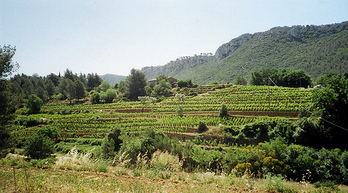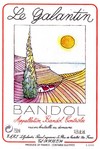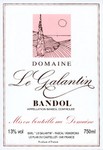
 |
| The tiny appellation of Bandol is located directly on the Mediterranean coast, just east of Marseille. Following the steps of her father Achille, who bought the land in 1960 and produced his first vintage in 1972, Céline Pascale took over the domaine in 1999. She is helped by her brother Jérôme, who takes care of the vineyards. Today, Domaine le Galantin farms 30 hectares of terraced vineyards located in Le Plan du Castellet. Everything is hand-harvested. Farming practices: Organic, not certified. The ancient steep vineyards of Bandol - first planted by Phocaean Greeks c.600BC - are the perfect home for Mourvèdre. This variety produces wines that can age at least three decades. As at le Galantin, the best vineyards are planted on poor clay and sandy soil on old terraces, known locally as restanques. The appellations's 1400 hectares of largely south facing vineyards get an extraordinary 3,000 hours of sun a year, but the heat is tempered by constant wind and also humidity from the sea. |
| Domaine Le Galantin Website |
 |
| Bandol Blanc |
| 60% Clairette, 35% Ugni Blanc and 5% Vermentino (Rolle). The grapes come from north-facing, low-yielding terraced vineyards planted on clay and limestone soil. White wine is rare in Bandol, accounting for only 5% of the appellation's total production. Following a cool fermentation (18C or 64F) during which the malolactic is blocked, the wine is fined and bottled early, in the spring following the harvest, in order to preserve its fresh qualities. The bouquet offers floral notes with a hint of the wild herbs of the garrigue coming from the mature Clairette vines. The palate is dominated by fresh fruits and a vivacious finish. 375 cases produced. |
 |
| Bandol Rosé |
| 55% Mourvèdre, with the rest equally divided between Cinsault and Grenache. The grapes are hand-harvested, after which the bunches are cooled down to 50C for a two day cold soak in order to extract fruit, color and aromatics. The juice is then racked off and the grapes are pressed to stainless steel tanks. 10% of the wine is saignée, the rest come from grapes treated as for making white wine. Following a cool fermentation (18C or 64F) during which the malolactic is blocked, the wine is fined and bottled. By law, Bandol rosé cannot be sold before March 1st. Classic Provençal rosé with delightful fresh berry fruit flavors and a crisp finish. Mineral and complex nose of red fruit and citrus. Around 5850 cases produced. |
 |
| Bandol Rouge |
| This wine is a powerhouse of dark berry fruit flavors with a lingering, complex finish. Produced from 95% Mourvèdre and 5% old-vines Grenache, it is fermented with indigenous yeasts and aged for 22 months in 70 to 90 hectolitre foudres and demi-muids (one new and the rest 2 to 6 year old) before release, which makes this tasty giant more approachable in its youth. Céline is employing 20% whole cluster fermentation (80% destemmed) and pressing after 20 days. 2500 cases produced. |
 |
| Bandol Rouge - Longue Garde |
| Only produced in special vintages, this wine is designed for "long aging" as the name implies. Crafted from the oldest parcels on the property, it offers depth and complexity. It otherwise receives the same aging as the regular cuvée, but is held for at least 5 years after bottling - sometimes much longer. 95% Mourvèdre and 5% old-vines Grenache, fermented with indigenous yeasts and aged for 22 months in 70 to 90 hectolitre foudres and demi-muids (one new and the rest 2 to 6 year old). Céline is employing 20% whole cluster fermentation (80% destemmed) and pressing after 20 days. 250 to 420 cases produced. |
| Copyright © 2002-2017 VOS Selections, Inc. |